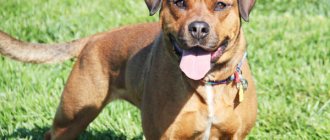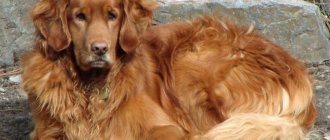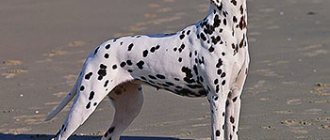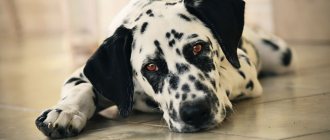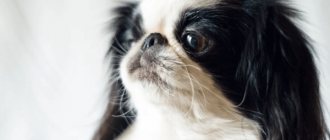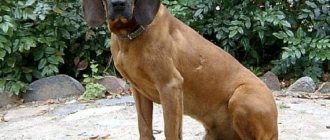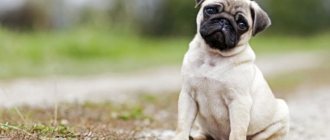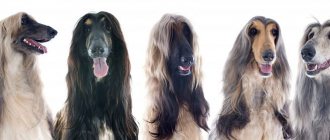History of the Dalmatian breed
Dalmatian
Mention of spotted dogs is found in documents that have reached us from different eras and states, starting from ancient Egyptian papyrus scrolls. However, based on meager verbal descriptions, it is simply impossible to reasonably judge who exactly was the ancestor of modern Dalmatians.
The first more or less reliable evidence of the existence of the breed dates back to the 16th–17th centuries. White dogs with small dark markings are depicted in surviving religious and secular works of art from that time: the altar painting in the Church of St. Mary (also known as "Gospe od anđela") in a small town on the resort island of Lošinj, a fresco in the Franciscan monastery in Zaostrog, church frescoes Santa Maria Novella in Florence, ceremonial portraits by Venetian and Tuscan artists, depicting influential nobles - for example, Cosimo II de' Medici. Since much of the earliest evidence was found in the historical region of Dalmatia, which is now part of Croatia, it is from here that the roots of the breed are usually traced. And the obvious consonance of the names speaks in favor of this version, officially adopted by the FCI.
There, on the warm shores of the Adriatic Sea, some “theoretical” works also saw the light of day. The Roman Catholic Archdiocese of Djakovo-Osijek has preserved in its archives the chronicles of Bishop Petar Bakic (1719) and Andreas Kecskemeta (1739), both talking about Croatian-specific dogs Canis Dalmaticus. In 1771, the Welsh naturalist Thomas Pennant wrote the book Synopsis of Quadrupeds, where he first named the Dalmatian breed. In 1790, English natural history scholar Thomas Bewick included Dalmatians in his General History of Quadrupeds.
In general, it should be said that it was in Britain that immigrants from Dalmatia gained particular popularity. Researchers suggest that representatives of other breeds were used for breeding here, in particular, black pointers and white English terriers. The latter died out more than a hundred years ago, but had a hand in the creation of many modern breeds: Boston Terrier, American Bulldog, Bull Terrier, American Staffordshire Terrier and others. Through the efforts of Foggy Albion breeders, by the second half of the 18th century, the appearance of Dalmatians that is recognizable today was formed.
Dalmatian puppy
At the same time, the “Italian dogs,” as the British initially called them, noticed their amazing ability to run almost tirelessly over long distances, not inferior in speed to horse-drawn carriages. Fleet-footed dogs were made guards of valuable “movable property” during city trips and long journeys - a kind of prototype of modern car alarms. In addition, during the trip, four-legged drivers followed the horses and, with light bites, forced tired or lazy animals to maintain the pace set by the coachman. Since then, the definition of carriage dogs has been assigned to them for several decades.
Although the functions of Dalmatians were not limited to this. They guarded houses, helped hunters of small and large game, and served as “bodyguards” for noble ladies walking without male company. During the Regency era, spotted pets became a sign of the high social status of the owner.
Once overseas, the unusual dogs changed their roles and, instead of rich nobles, accompanied voluntary fire brigades, which, before the mass introduction of internal combustion engines, could not do without real “horsepower”. White “bells” visible from a distance served as a warning to other road users about the approach of fire fighters and helped clear the way just as well as sirens and light signals. But even after the fire-fighting carriages became museum exhibits, many did not want to part with their living talismans. Today, charismatic dogs are a recognizable symbol of US firefighters.
As for the exhibition history, dogs from Dalmatia were first presented to a professional jury and the public in 1860 in Birmingham. Thirty years later, a breeders' club was created and an official breed standard was formulated. Two years earlier, she was recognized by the American Kennel Club. The international canine organization FCI registered Dalmatians in 1926.
The first representatives of the spotted brethren appeared in Moscow in 1982, but breeding on the territory of the USSR progressed very slowly due to a lack of fresh blood. And the demand for puppies was small, since many dog lovers simply had no idea about the existence of the breed. Specialty clubs arose only at the dawn of the 90s. Today, the largest concentration of kennels and owners of Dalmatians is in the capital, St. Petersburg, Nizhny Novgorod, Yekaterinburg, Novosibirsk and some other cities.
Dalmatian standard FCI* No. 153/14.04.1999
| Standard | Comments | Breeders' opinions | History of the breed |
Origin:
Dalmatia, Republic of Croatia
Date of publication of this standard:
04/14/1999-04-29
Purpose:
Companion dog, family dog, easily trained as a working and rescue dog.
| FCI classification: | Group 6 | Hounds and related breeds |
| Section 3 | Related breeds | |
| No operational tests | ||
BRIEF HISTORY
The origin of Dalmatians is still unclear and is based solely on speculation. Based on drawings found in the burials of ancient Egyptian pharaohs and similar drawings dating from the 16th to 18th centuries, it can be assumed that Dalmatians have existed for several thousand years. Church records from the 14th century, as well as those dating back to 1719, definitely point to the breed's origins in the Mediterranean region, particularly in the vicinity of the Dalmatian coast. The earliest depictions of the breed can be found in paintings by Italian artists of the 16th century, and in frescoes in Zaostog (Dalmatia), which can be approximately dated to 1710. A work by Thomas Bewick, published in 1792, contains a description and drawing of a Dalmatian, which Bewick calls "Dalmatian or Coach Dog". The first Dalmatian standard was written by an Englishman named Vero Shaw in 1882, and in 1890 this standard became the official breed standard.
GENERAL FORM
The Dalmatian is a well balanced, distinctively colored, strong, muscular and active dog. Symmetrical lines, devoid of coarseness and clumsiness and by definition a “carriage dog” is very durable and capable of moving quickly.
IMPORTANT PROPORTIONS
Body length: height to length = approximately 9:10 Skull length: muzzle length = 1:1
BEHAVIOR AND TEMPERAMENT
Sociable and friendly, not timid or indecisive, not nervous or aggressive.
HEAD
— rather long
CRANIAL REGION Skull:
flat, rather wide between the ears, well-defined temples.
Minor groove. Completely wrinkle free. Stop:
moderately pronounced.
FACIAL REGION Nose:
The nose of black-spotted dogs is always black, while that of brown-spotted dogs is always brown.
Muzzle:
long, full.
The bridge of the nose is straight and parallel to the outer line of the skull. Lips:
clean, fairly tight to the jaws, not drooping.
Full pigmentation is desirable. Jaws/Teeth:
Jaws are strong with an excellent and regular scissor bite.
A complete set of 42 teeth is desirable (according to the dental formula). The teeth are straight and white. Eyes:
Moderately set apart, medium in size, round, bright and brilliant with an intelligent and alert expression.
The color is dark brown in black spotted dogs, light brown to amber in brown spotted dogs. The rim of the eye is completely black in black-spotted dogs and completely brown in brown-spotted dogs. The eyelid is adjacent to the eyeball. Ears:
Set rather high, medium in size, fairly wide at the base. They are held close to the head, gradually tapering to rounded ends. Thin to the touch, the markings are well defined, spotted ones are preferred.
NECK
rather long, with a beautiful curve, tapering towards the head, without dewlap.
TORSO
Back:
strong, level
Loin:
clean, muscular and slightly rounded.
Croup:
with a very slight slope.
Chest:
- not too wide, but deep and voluminous.
The lower part should reach the elbow. The front of the chest is clearly visible in profile. The ribs are proportional, long, slightly rounded, never flat, barrel-shaped or poorly formed. Sides:
groin narrow.
Bottom line:
The belly is well tucked.
TAIL
Approximately reaches the hock joint. Strong at the base, gradually thinning towards the end, not coarse. Set neither too low nor too high. When calm, carried downward with a slight upward curve in the lower third of the tail. When moving, carried slightly above the topline, but never vertically (fun tail) or curled. Spotted is preferred.
LIMBS
Forelegs:
completely straight with strong, round bones along all lengths.
Shoulders:
Moderately sloping, clean and muscular.
Elbows:
pressed to the body, never turned to one side or the other.
Pasterns:
straight, slightly sloping.
Hindquarters:
Round, clean, muscular.
When viewed from behind, vertical and parallel. Metatarsus:
Well sloping.
Shin:
strong.
Hock:
Strong, well sloping.
Paw:
Round, compact, with well-knit toes (“cat’s paw”). The pads are round, firm and elastic. The nails are black or white in black spotted dogs and brown or white in brown spotted dogs.
GAIT/MOVEMENT
Very free. Smooth, strong, rhythmically active with a very long stride and good reach of the forelimbs. When viewed from behind, the limbs move in parallel, the hind legs following the forelegs. Short strides and raking movements are incorrect.
COAT
Coat:
Short, harsh, dense, shiny and glossy.
Color:
main color is pure white. The black-spotted variety has black spots, the brown-spotted variety has brown spots; the spots are round, not merging, well defined, and distributed as evenly as possible. Size 2-3 cm in diameter. The spots on the head and limbs are smaller than on the body.
SIZE AND WEIGHT
The overall balance is most important. Height at withers for males: 56-61 cm Height at withers for females: 54-59 cm Weight: For males approximately 27-32 kg For females approximately 24-29 kg
FLAWS
Any deviation from the above shall be regarded as a defect, the seriousness of which depends on the degree of expression.
DISQUALIFYING FAULTS
NOTE:
Males must have two normally developed testes, fully descended into the scrotum.
RECOMMENDATIONS:
To reduce the incidence of deafness in Dalmatians (20-30%):
This is the standard that guides experts at dog shows in Russia.
| Standard | Comments | Breeders' opinions | History of the breed |
Comments on the new standard
In the breed standard, every word has a very big meaning and is discussed and weighed for a long time. It is very difficult to accurately translate the standard into another language, because during this translation the meaning of the word may involuntarily be slightly changed or lost. When changes are made to a standard, sometimes a small touch, replacing a word with a synonym or adding an epithet, is enough to give the description a different flavor. In the new version of the Dalmatian standard there are many such small changes-touches, and behind each of them there is a long discussion. Let us dwell on some of the most important, in our opinion, details of the new standard.
Purpose.
The previous version of the standard stated that the Dalmatian is “easily trained as a companion dog,” while the new version states that the Dalmatian is “easily trained as a
working
dog.” Apparently, the authors of the standard are striving to make the Dalmatian a more serious breed.
General form.
The new standard adds the phrase “well balanced.” Indeed, for the Dalmatian, as for any running breed, the overall balance, that is, the relationship between the various parts of the body, is very important. Experienced experts always note the presence or absence of balance in the descriptions. It happens that a dog is, in principle, built correctly, but you look at it and it seems that the front part is too heavy and bulky, and the back part looks like it came from another dog. This imbalance greatly spoils the overall impression, so the authors of the standard decided to pay special attention to it.
Important proportions.
For the first time, the standard specifies the basic proportions. Really, how long should the muzzle be? The standard says “long”, but how long? Now everything is clear and clear - the length of the muzzle should be equal to the length of the skull. Actually, this is exactly the length of the muzzle in most breeds that have some external resemblance to Dalmatians - setters, Dobermans, pointers, etc. The introduction of exact proportions of the body format is much more important and fundamental. Until now, this most important question has somehow been omitted. Each expert left the format to his own discretion - one likes dogs with a format like a Boxer or Doberman - square, the other - more elongated. The Dalmatian format was different in different countries. For example, Scandinavians have always preferred longer Dalmatians. It makes a lot of sense that Dalmatian's format is longer. This breed must be capable of long runs, with wide, sweeping movements, and it is this format that produces the best trot. It must be said that currently in our country, and in many others, there are a lot of champion dogs of almost square format. Apparently, over time, this type will be replaced by “longer” Dalmatians. This standard sets the proportion of body length to height as 10:9, that is, the format is 111.
Head and cheekbones.
In the previous version of the standard, the transition from the forehead to the muzzle was said to be “well expressed”, and in the new version it was said to be “moderately expressed”. That is, the creators of the standard do not want to see the “stop” as sharp and warn against it. The description of the muzzle adds: “the bridge of the nose is straight and parallel to the outer line of the skull,” that is, it should be parallel to the line of the forehead. Not too often, but there are dogs with a slightly upturned or slightly downturned muzzle, which is a rather serious fault.
Before the lips
were supposed to fit tightly around the jaws, now there is a small amendment - “quite tight”, that is, experts from now on may not be too picky. In order to combat pigmentation, the phrase “lip pigmentation is desirable” has been added.
Teeth.
Until now, in all Dalmatian standards, in the “teeth” section, only the scissor bite was described. Now experts must count the number of teeth - there should be 42. However, the punishment for missing teeth is left to the discretion of the expert - the standard does not say anything about this. That is, the expert has the right not to reduce the rating of the dog he likes or to treat it with the utmost severity.
eye color has been slightly changed
. The old standard says “dark in black-spotted dogs,” and the new standard says “dark brown.” The color of the eyelid edging should now only be black, and not “black or very dark” as before. Apparently, there is again a struggle for good pigment. The description of the eyelids also added the phrase: “The eyelid is adjacent to the eyeball.” Probably, a number of dogs have appeared with rather damp, slightly drooping lower eyelids and thus the creators of the standard insure us against their spread.
There is a slight adjustment in ear
- they should be slightly lower than before (“moderately high”). The phrase from the previous standard “well stained” is explained in more detail. So, the ear markings should be “well defined, spotted preferably.” That is, too dark, marbled ears are definitely a fault.
Neck length
in the new standard it became a little shorter - not “quite long”, but moderately long. Previously it was also “light”, now this term has disappeared.
Quite large changes can be found in the description of the torso
, especially the breasts. The main feature is that according to the new standard, the front part of the chest, which experts often call “forebreast,” must be well developed. Indeed, many Dalmatians' chests, when viewed in profile, are completely flat, like a terrier's, which is undesirable. The ribs should be long, that is, extend far back. All these nuances are necessary for a running dog; it must have enough space in its chest for the lungs to work.
Description of the tail
although it has changed, in general it is similar to the previous one. However, the authors of the standard indicated that in movement it should be carried slightly above the level of the back, while strictly stipulating that it should be saber-shaped and not twisted. Until now, the problem with the tails of Russian (and not only Russian) Dalmatians is very relevant. It’s good that the authors of the standard stand their ground and do not change its form.
In the description of the forelimbs
a new detail appears - they should have “strong, round bones along the entire length.” Apparently, this is how it is argued that the backbone should be stronger than before. Indeed, light-boned dogs almost always have thin, flat pasterns.
Height
Dalmatians at the withers remained unchanged, but in the new standard the dogs became significantly heavier. The previous weight of dogs - 27 kg for males and 24 for females - is now considered the minimum, and the maximum is 5 kg more. What could cause this weighting to occur? Of course, due to the bones, and not excess fat! Consequently, the Dalmatian in the new standard, with the continued growth of the carriage dog, should become more significantly massive than before.
In the new standard, a completely new phrase appears that pigmented testes are desirable for male dogs. There is no point in dwelling on this specifically; this wish relates to the general improvement of pigmentation, and whether to pay attention to this or not is at the discretion of the experts.
Vices.
Bronzing (temporary lightening of spots in black Dalmatians) was considered a disqualifying fault in the previous standard, but in the new standard such a dog is not removed from the ring, but the score is significantly reduced.
And finally the last thing. The new standard has a very important final part, for the sake of which it was, in fact, redone. These are recommendations regarding the use in breeding of dogs with congenital spots. As you know, until now these dogs have been excluded from breeding. And in the new standard, congenital spots are still classified as disqualifying defects. However, as stated in the recommendations, by using dogs with “spots”, the authors of the standard hope to improve the situation with deafness in the breed. Indeed, according to American and European researchers, the percentage of deaf Dalmatians there has reached a very high figure - 20-30 percent of puppies born have some kind of hearing problem. Although dogs in our country do not undergo hearing testing using the BAER device, we can confidently say that the percentage of deaf dogs in our country is much lower. In particular, the number of bilaterally deaf people does not exceed 2 percent of the total number (8% in America). This allows us to say that the problem of deafness and, as a consequence, the use of dogs with congenital spots in breeding to improve the situation, is not as relevant in Russia as in many other countries. Our Dalmatians are far from ideal and in the coming years we should fight to improve their appearance, psyche and other parameters. Therefore, we do not see the need to currently use dogs with congenital spots in Russia. In most countries, the show score does not affect whether or not a given dog is included in breeding. Each breeder (and it is the breeders there who decide who and with whom they should breed) has his own point of view on breeding and adheres to it in his work. Thus, they are simply legally allowed to use dogs with "spots". Whether to do this or not - everyone will decide for themselves. However, as far as we know, the vast majority of well-known nurseries do not plan to take advantage of the new right to breed “spotted” sires. In Russia the situation is somewhat different. A rating from an exhibition, no less than “very good” for females and “excellent” for males, is like a “pass” to breeding. These are the rules of the RKF, and all clubs and private nurseries adhere to them in their work. In this regard, it is not yet entirely clear how these dogs can be used. The RKF has not yet been able to answer us what potential assessment a dog with a monocle or a spot on the ear will receive if it participates in the exhibition. So for now, we do not advise owners of former “defective” Dalmatians to rush to exhibitions. It is worth waiting until experts in our country and abroad come to an agreement on how to treat these dogs in the rings, and the experts will have the opportunity to familiarize themselves with the innovation. There is one more discrepancy. The standard states that dogs with minor congenital spots can be bred. This wording seems rather vague. If the area of the spot is not specified, the interested parties - the expert, the dog owner, the breeder and the dog handler - may disagree on whether the spot is large or not very large. It would be much better to stipulate the maximum permitted area of the congenital spot. After all, they can be small, covering 1/3 of the ear, or ugly, covering half the head, like a marbled Great Dane.
To summarize, we can say that in the new standard the Dalmatian looks somewhat stronger, more massive, has a longer body, and more attention is paid to the pigmentation of individual parts - lips, ears, eyelids, testes, etc. This new type of Dalmatian, enshrined in the standard, today quite accurately describes the Scandinavian dogs - Finnish or Swedish, and is also quite close to the Dalmatians bred in England. These dogs do very well in shows - they stand out in the rings with their size and proportions, and also have excellent movements. One cannot but agree that the new standard is progressive, and that part of it that concerns the use of dogs with congenital spots may be changed over time. This may happen if the situation with deafness improves radically or, on the contrary, it is discovered that the use of these dogs does not significantly affect the hearing problem.
| Standard | Comments | Breeders' opinions | History of the breed |
* FCI - Federation Cynologique International (Federation Cynologique International) unites dog clubs from more than 50 countries in Europe, America, Asia, Africa, Australia and New Zealand. England, USA and Canada are not members of the FCI.
Return to articles
Home | We and our Dalmatians | Standard and history | Education and care | Exhibitions | Choosing a Puppy | Our friends | Links | Forum
Dalmatian appearance
Athletic and hardy, elegant dogs of medium to large size. Males weigh on average 18-27 kg with a height at the withers of 58-61 cm, females - 16-24 kg and 56-58 cm, respectively.
Head
Dalmatian face
The Dalmatian's head is proportional to the body. Long, flat, not too wide between the ears. The muzzle has a pronounced stop and is equal in length to or slightly shorter than the occipital part. There are no folds of skin on the head.
Ears
Moderately large, set wide on the head, pressed to the sides. Triangular in shape, tips slightly rounded. The color is necessarily spotted, matching the general coloring.
Eyes
Dalmatians have medium-sized, oval-shaped eyes. The color corresponds to the coat: dark brown for dogs with black spots, amber for dogs with brown spots. The look is clear and intelligent. The eyelids fit well to the eyeball. Their edges are well pigmented (depending on color - black or brown).
Nose
The lobe is wide, fully pigmented (black or brown in accordance with the base color), the nostrils are wide open.
Lips and teeth
The lips fit tightly to the jaw. The jaws are strong. The bite is scissor-shaped, with the upper teeth completely overlapping the lower teeth.
Neck
Strong, quite long.
Frame
The Dalmatian's body is well built, with muscular shoulders, a deep chest and well-arched ribs. The back is straight and powerful. The loin and croup are muscular, the slope is slight.
Limbs
The front legs are straight, elbows pressed to the body. The hind legs are muscular, the knees are strong and well developed. The paws resemble those of a cat: compact and round, with arched toes. The claws can be pigmented depending on the base color.
Tail
The Dalmatian's tail is quite long, spotted, and straight. It is thicker at the base and tapers towards the tip.
Wool
Short, dense, smooth, glossy, hard.
Dalmatian with black spots
Color
On a mostly white background there are black or brown (exactly the same color!) spots with clear contours, which are located symmetrically along the body, on the head, ears and tail.
Breed standard
The Dalmatian in the photo looks like a harmonious, balanced dog with a characteristic, recognizable color. He has a strong and muscular body, which is also symmetrical.
The Dalmatian is an active dog that requires daily walks with the opportunity to run
The length of the muzzle is proportional to the length of the skull. The skull itself is flat and wide between the ears. The groove between the eyebrows is weakly expressed, unlike the temples. The transition from forehead to muzzle is also very moderate.
The pigmentation of the nose is variable. If the dog has a black-spotted color, then the nose is black. Brown-spotted individuals have brown lobes. The long muzzle is completed by lips that fit tightly to the jaw. The jaws themselves are strong, and the even and white teeth have a scissor bite.
The dog looks at the world with widely spaced, round, bright, medium-sized eyes that sparkle and have a smart, wary expression. Variations in color are acceptable from dark brown in black-spotted dogs to light brown and amber in chocolate dogs.
The thin ears are set high, wide at the base and rounded at the end. The beautiful neck expands towards the voluminous chest. The body looks strong and even, the lower back is muscular and rounded, the stomach is tucked. The Dalmatian is equipped with a tail that is strong at the base and tapers towards the end. The tail has a medium set and hangs down when calm. May be slightly curved.
The breed has short, hard-to-touch, thick fur that shines in the sun. An important feature of the color is that the main color is always white. The dog may have either black or brown spots, which are round in shape, have clear boundaries, and are evenly distributed.
With a height of up to 61 cm, males weigh from 28 to 32 kg. Bitches have a height at the withers of up to 59 cm, and their weight should not exceed 29 kg. Disqualifying defects include all kinds of malocclusions, entropion and eyesores, multi-colored eyeballs and blue eyeballs.
Dogs often suffer from deafness, which is also considered a defect. Any type of color other than black and white or brown and white is also considered unacceptable. In addition, the dog should not be timid or overly aggressive.
Photo of an adult Dalmatian
Dalmatian character
Dalmatians are not suitable for inexperienced owners and people who need the company of a phlegmatic "couch" dog. Incredibly active by nature, without proper physical activity, they direct unspent energy into destructive pranks, causing damage to their homes. In such a situation, the animal becomes uncontrollable, it does not obey commands and completely ignores prohibitions.
Dalmatian plays with a child
Failure to understand the background of this behavior led to the formation of the erroneous opinion of low intelligence. If the Dalmatian does not respond to “No!” and “Come to me!”, this does not mean at all that he is stupid. The point is simply that the owner made serious mistakes when raising him, did not assert his authority and continues the chain of mistakes by not satisfying the natural needs of the pet for physical exercise.
Proper training, a balanced and calm relationship with the puppy, and early socialization contribute to the formation of a healthy and strong psyche. Such dogs perfectly sense a person’s mood and adapt to it, they are happy to follow commands, do not start fights in walking areas, are reserved with strangers, and are friendly towards animals.
Boss, you are the best!
Dalmatians do not become attached to one “their” person; they love and protect all household members equally, and at the same time strive to take an active part in everything that people do. They get along well with other pets, especially if they grow up with them. There is a long-standing craving for the company of horses in the genes, but few people today own a stable, so the company of a dog or cat would be suitable.
For a family with small children, the appearance of an energetic “plum pudding,” as the English affectionately call these dogs, can be a problem. But not because they are naturally aggressive and capable of deliberately harming the little one. On the one hand, impetuous and abrupt by nature, Dalmatians do not measure up to their strength and often knock down children who are inappropriately on the way. On the other hand, animals with hearing problems instinctively defend themselves from the “threat” when they are quietly approached from behind or disturbed in their sleep, and it is difficult for little ones to immediately learn the intricacies of handling a special family member.
But in most cases, Dalmatians get along just fine with older children and teenagers, feeling a kindred restless soul.
Education and training
Dalmatians are one of the breeds for which proper training and early socialization are incredibly important. A freedom-loving character, unbridled energy, and hunter instincts without control and restraint mechanisms formed in childhood lead to the appearance of an uncontrollable, destructive adult animal.
Dalmatian training
Learning basic commands and interacting with the outside world cannot be put on hold. From the first days a puppy appears in your home, a training program should start. The little Dalmatian must clearly understand the boundaries of what is permitted and know that disobedience will have consequences. Of course, it is unacceptable to show aggression and use physical force, but the owner’s firm and stern voice, in which dissatisfaction is clearly expressed, is in itself sufficient punishment.
Do not forget that visits to walking areas and participation in group classes with a dog handler can only begin when the puppy has received the required doses of mandatory vaccines and sufficient time has passed for the formation of immunity to diseases dangerous to the pet. It's best to check with your veterinarian.
Well-trained dogs already know and easily carry out more than a dozen commands by the age of six months, including both standard and “artistic” ones such as successive flips, “High five!” or bows. In general, it must be said that spotted circus performers love attention and are ready to make a lot of effort to make their owners smile.
Care and maintenance
The ideal option for keeping a Dalmatian would be a spacious private house with a securely fenced area where he can roam freely during the day. However, it must be remembered that representatives of this breed cannot live permanently in an enclosure in our climatic conditions - short hair does not protect against low temperatures.
If you are the owner of a city apartment, long walks are a prerequisite for a peaceful existence. Moreover, not only the duration is important (at least an hour a day), but also the intensity of the load. It's best to have your dog on a leash accompany you on your run or bike ride - moving at a fast pace will burn off enough energy to not have to look for adventure when you return. An alternative could be exercises on an equipped obstacle course, just be sure to correctly measure the dog’s physical condition and the height of the barriers.
Dalmatians do not require complex and tedious care. Their “coat” does not fall off and does not need trimming or frequent washing, however, shedding occurs profusely and almost continuously, and becomes especially severe at the border of warm and cold seasons. To keep fur in the house to a minimum, it is recommended to brush your pet as often as possible (at least 2-3 times a week) with a brush or a special mitten.
Otherwise, standard procedures are enough: monitor the condition of the ears and eyes, the length of the claws, and regularly brush your teeth with veterinary paste. Nutrition should be balanced and healthy. The easiest way to achieve this is with ready-made premium and super-premium food. Remember that overeating combined with low physical activity can lead to obesity.
Keeping a Dalmatian in an apartment
The characteristics of the Dalmatian breed indicate that it is an unpretentious dog that will be comfortable in an apartment and in the countryside. When keeping a Dalmatian in an apartment, you should remember that the dog sheds all year round, so there will always be fur on clothes, carpets and pieces of furniture. To minimize the amount of hair indoors, your pet should be combed daily using a special brush or rubber mitt.
Since the dog gets dirty a little, bathe it as needed, that is, when it is very dirty, or 2 times a month. After a walk, wipe the paws with a damp cloth, and check the condition of the ears, teeth, and claws once a week. Plaque is removed with tooth powder, which is sold at a pet store.
Caring for a Dalmatian requires increased attention to the pet; if it is lacking, the dog will begin to chew shoes and furniture out of boredom.
Dalmatian Health and Diseases
Dalmatian with heterochromia eyes
The average life expectancy of Dalmatians is 10-13 years.
The biggest problem of the breed is deafness. Hearing problems of varying severity occur in almost a third of dogs. 12% of Dalmatians are born completely deaf. An effective solution has not yet been found. Although only healthy animals are allowed for breeding, they also produce sick puppies. The latter, however, lead a full life as pets. This deficiency can be identified in the first weeks using modern tests.
Due to their metabolic characteristics, Dalmatians often develop bladder stones. They are also prone to skin allergies and hip dysplasia. Less commonly recorded are epilepsy, autoimmune liver diseases, osteochondrosis of the shoulder joint, osteomyelitis, dilated cardiomyopathy, hypothyroidism, laryngeal paralysis and other nonspecific diseases.
Since many diseases are hereditary or congenital in nature, their occurrence can be predicted taking into account the pedigree. Responsible breeders always provide comprehensive information about the health status of parents and grandparents.
How to choose a puppy
The key to a successful purchase is a balanced and carefully thought-out choice of breeder. Only nurseries with an impeccable reputation can guarantee that the new member of your family will be physically healthy and psychologically stable. Since Dalmatian puppies are given to permanent owners no earlier than 10-12 weeks, they have time to undergo the necessary medical examinations and show their character traits.
A good breeder will ask you as many questions as you ask him, because for him, every four-legged baby is not a living commodity, but an individual, so it is important to understand in what family he will live, in what conditions.
And you, in turn, have every right to meet the parents and study their documents, the veterinarian’s report on the puppy’s health condition and the results of the BAER test (Brainstem Auditory Evoked Response) - an electrodiagnostic hearing test.
It is important to see the conditions in which the mother and babies are kept, learn about nutrition and personally communicate with the puppy you like in order to evaluate its ability to make contact with people and adequately respond to the outside world.
Appearance
The characteristics of the breed describe Dalmatians as large, hardy, intelligent and loyal dogs with an athletic build. Naturally, the early representatives differ somewhat from the modern description of the breed. The Dalmatian has the features of a Setter, a Pointer and a noble Dog. The standard establishes ideal criteria for the height and weight of dogs, but body proportions are much more important than generally accepted indicators:
- Males: 56–61 cm; 27–32 kg.
- Females: 54–59 cm; 24–26 kg.
- Height at the withers relates to the length of the body in a ratio of 9:10.
- The lengths of the muzzle and the frontal part of the skull are equal, that is, they are correlated in a 1:1 ratio.
Breed standard
- The head is in the shape of a regular, wide wedge with a U-shaped end. The forehead is wide, slightly rounded, divided by a furrow. Cheekbones are well defined. The skin is taut, without loose folds (in puppies, arched “brow folds” are allowed). The transition to the muzzle is blurred. The muzzle is wide, the bridge of the nose is straight. The lips are quite dense and should not sag or look raw. It is desirable that the pigmentation of the extreme line of the lips be full, rich, and match the color of the spots.
- The teeth are strong, perfectly straight, completely white, and fit tightly together without any gaps. The fangs are large. Scissor bite.
- The nose is wide, with open nostrils, pigmentation to match the spots.
- The eyes are oval, medium in size, not set too wide. The range of pigmentation of the iris ranges from light to dark brown. The eyelids are fully pigmented, matching the spots.
- The ears are drooping, wide at the base, rounded at the tips. Ear cartilage is soft and thin. In a calm state, the ears are pressed to the head, and in an alert state they are turned forward.
- The body is toned, muscular and streamlined. The neck widens towards the shoulder girdle, there is a well-defined bend. The withers are raised, the back is strong, not too wide, the joints of the croup are hidden by muscles, moderately sloping. The chest is deep to the elbows, the keel bone is well arched, the ribs are moderately rounded. The groin line is tight.
- The limbs are perfectly straight, the elbows are pressed to the chest. The structure is muscular, the skin is “dry”. The fingers are gathered into a tight ball. The claws are either naturally white or match the color of the spots.
- The tail is of standard length (to the hock joints), tapering towards the end. Set on at an average level in relation to the back, straight, slightly curved in the lower third. In a natural position it carries low, and in an excited position it carries above the line of the spine, but not vertically. The tails of Dalmatian puppies are “indicators of breed quality”; if the baby does not have spots on the tail, it is immediately culled.
Coat type and color
The Dalmatian is a short-haired dog with close-fitting, semi-rigid, shiny guard hair. There is no undercoat. The main color is perfect white, without shades. The spots are black or deep brown, extremely clear, evenly spaced up to 3 cm in diameter. There are fewer markings on the paws and head than on the body.
Photos of Dalmatian puppies
How much does a Dalmatian puppy cost?
On private advertisement sites, they ask for a young Dalmatian “without documents” from 4 to 8 thousand rubles.
But you must understand that in this case it is impossible to know whether both parents were actually representatives of the breed you are interested in. And what is even more important, there is no guarantee that over time the animal will not develop certain pathologies that are life-threatening or significantly affect its quality. The price of Dalmatians in kennels varies in different regions and fluctuates even more significantly based on which class a particular puppy belongs to. Depending on individual characteristics and compliance with the breed standard, puppies from the same litter with FCI documents and veterinary passports will cost from 15-20 to 40-50 thousand rubles. And here it’s up to you to decide whether you plan to participate in exhibitions with the prospect of big victories or whether it’s enough that a devoted and mischievous friend appears in your home.
Disqualifying faults
- Entropy, ectropy, cataract, heterochromia
- Blue eye color (recommended to exclude from breeding)
- Severe underbite or overshot
- Lack of more than 6 premolars
- Longhair
- Deafness in one or both ears (recommended to exclude from breeding)
- Coat color that does not meet the Dalmatian breed standard: lemon or orange, black and brown spots on one dog.
- Congenital spots around the eyes or elsewhere (not allowed for exhibition, but allowed for breeding).
- Shyness, cowardice or aggression.
